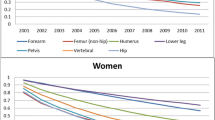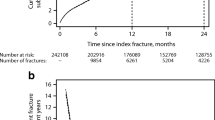Abstract
Summary
We investigated the incidence of fragility fractures from 2010 to 2012 in Sakaiminato, Japan. The incidence rates of limb fractures in Sakaiminato were lower than in Caucasian populations but had increased relative to data obtained in Japan in the 1990s. Clinical vertebral fractures occurred at higher rates in Sakaiminato than in Caucasian populations.
Introduction
To elucidate the incidence and prognosis of fragility fractures in Sakaiminato, Japan.
Methods
A survey of all hip, distal radius, proximal humerus, and clinical vertebral fractures was performed from 2010 to 2012 in patients aged 50 or older in Sakaiminato city, Tottori prefecture, Japan. The age- and gender-specific incidence rates (per 100,000 person-years) were calculated based on the population of Sakaiminato city each year. The incidence rates of hip, distal radius, and proximal humerus fractures were compared with previous reports. We conducted a follow-up study assessing patients within 1 year following their initial treatment at two Sakaiminato hospitals.
Results
The age-adjusted incidence rates in population aged 50 years or older (per 100,000 person-years) of hip, distal radius, proximal humerus, and clinical vertebral fractures were, respectively, 217, 82, 26, and 412 in males and 567, 432, 96, and 1229 in females. Age-specific incidence rates of hip, distal radius, and proximal humerus fractures all increased since the 1990s. Our study also revealed that anti-osteoporotic pharmacotherapy was prescribed 1 year post-fracture at rates of 29, 20, 30, and 50 % for patients with hip, distal radius, proximal humerus, and clinical vertebral fractures, respectively.
Conclusions
The incidence rates of limb fractures in Sakaiminato were substantially lower than Caucasian populations in northern Europe but had increased relative to data obtained in Japan in the 1990s. Unlike upper and lower limb fractures, clinical vertebral fractures occurred at higher rates in our study population than in other Asian and North European countries.
Similar content being viewed by others
References
Yan L, Zhou B, Prentice A, Wang X, Golden MH (1999) Epidemiological study of hip fracture in Shenyang, People’s Republic of China. Bone 24:151–155
Morales-Torres J, Gutierrez-Urena S (2004) The burden of osteoporosis in Latin America. Osteoporos Int 15:625–632
Hagino H, Yamamoto K, Ohshiro H, Nakamura T, Kishimoto H, Nose T (1999) Changing incidence of hip, distal radius, and proximal humerus fractures in Tottori Prefecture, Japan. Bone 24:265–270
Lonnroos E, Kautiainen H, Karppi P, Huusko T, Hartikainen S, Kiviranta I, Sulkava R (2006) Increased incidence of hip fractures. A population based-study in Finland. Bone 39:623–627
Bjørgul K, Reikerås O (2007) Incidence of hip fracture in southeastern Norway: a study of 1,730 cervical and trochanteric fractures. Int Orthop 31:665–669
Lippuner K, Johansson H, Kanis JA, Rizzoli R (2009) Remaining lifetime and absolute 10-year probabilities of osteoporotic fracture in Swiss men and women. Osteoporos Int 20:1131–1140
Pentek M, Horvath C, Boncz I, Falusi Z, Toth E, Sebestyen A, Majer I, Brodszky V, Gulacsi L (2008) Epidemiology of osteoporosis related fractures in Hungary from the nationwide health insurance database, 1999–2003. Osteoporos Int 19:243–249
Dimai H, Svedbom A, Fahrleitner-Pammer A, Pieber T, Resch H, Zwettler E, Thaler H, Szivak M, Amrein K, Borgstrom F (2013) Epidemiology of proximal humeral fractures in Austria between 1989 and 2008. Osteoporos Int 24:2413–2421
de Putter CE, Selles RW, Polinder S, Hartholt KA, Looman CW, Panneman MJ, Verhaar JA, Hovius SE, van Beeck EF (2013) Epidemiology and health-care utilisation of wrist fractures in older adults in The Netherlands, 1997–2009. Injury 44:421–426
Hagino H, Furukawa K, Fujiwara S, Okano T, Katagiri H, Yamamoto K, Teshima R (2009) Recent trends in the incidence and lifetime risk of hip fracture in Tottori, Japan. Osteoporos Int 20:543–548
Koh LK, Saw SM, Lee JJ, Leong KH, Lee J, Osteoporosis NWCo (2001) Hip fracture incidence rates in Singapore 1991–1998. Osteoporos Int 12:311–318
Brauer CA, Coca-Perraillon M, Cutler DM, Rosen AB (2009) Incidence and mortality of hip fractures in the United States. JAMA 302:1573–1579
Kaastad TS, Meyer HE, Falch JA (1998) Incidence of hip fracture in Oslo, Norway: differences within the city. Bone 22:175–178
Melton LJ, Kearns AE, Atkinson EJ, Bolander ME, Achenbach SJ, Huddleston JM, Therneau TM, Leibson CL (2009) Secular trends in hip fracture incidence and recurrence. Osteoporos Int 20:687–694
Kannus P, Niemi S, Parkkari J, Palvanen M, Vuori I, Jarvinen M (2006) Nationwide decline in incidence of hip fracture. J Bone Miner Res 21:1836–1838
Goettsch WG, de Jong RB, Kramarz P, Herings RM (2007) Developments of the incidence of osteoporosis in The Netherlands: a PHARMO study. Pharmacoepidemiol Drug Saf 16:166–172
Chevalley T, Guilley E, Herrmann FR, Hoffmeyer P, Rapin CH, Rizzoli R (2007) Incidence of hip fracture over a 10-year period (1991–2000): reversal of a secular trend. Bone 40:1284–1289
Chang KP, Center JR, Nguyen TV, Eisman JA (2004) Incidence of hip and other osteoporotic fractures in elderly men and women: Dubbo Osteoporosis Epidemiology Study. J Bone Miner Res 19:532–536
Amin S, Achenbach SJ, Atkinson EJ, Khosla S, Melton LJ (2014) Trends in fracture incidence: a population-based study over 20 years. J Bone Miner Res 29:581–589
Boufous S, Finch C, Lord S, Close J, Gothelf T, Walsh W (2006) The epidemiology of hospitalised wrist fractures in older people, New South Wales, Australia. Bone 39:1144–1148
Jónsson B, Bengnér U, Redlund-Johnell I, Johnell O (1999) Forearm fractures in Malmö, Sweden. Changes in the incidence occurring during the 1950s, 1980s and 1990s. Acta Orthop Scand 70:129–132
Oskam J, Kingma J, Klasen HJ (1998) Fracture of the distal forearm: epidemiological developments in the period 1971–1995. Injury 29:353–355
Palvanen M, Kannus P, Niemi S, Parkkari J (2006) Update in the epidemiology of proximal humeral fractures. Clin Orthop Relat Res 442:87–92
Siggeirsdottir K, Aspelund T, Jonsson BY, Mogensen B, Gudmundsson EF, Gudnason V, Sigurdsson G (2014) Epidemiology of fractures in Iceland and secular trends in major osteoporotic fractures 1989–2008. Osteoporos Int 25:211–219
Cauley JA, Chalhoub D, Kassem AM, Fuleihan G-H (2014) Geographic and ethnic disparities in osteoporotic fractures. Nat Rev Endocrinol 10:338–351
Chau PH, Wong M, Lee A, Ling M, Woo J (2013) Trends in hip fracture incidence and mortality in Chinese population from Hong Kong 2001–09. Age Ageing 42:229–233
Chan DC, Lee YS, Wu YJ, Tsou HH, Chen CT, Hwang JS, Tsai KS, Yang RS (2013) A 12-year ecological study of hip fracture rates among older Taiwanese adults. Calcif Tissue Int 93:397–404
Kanis JA, Johnell O, Oden A, Sembo I, Redlund-Johnell I, Dawson A, De Laet C, Jonsson B (2000) Long-term risk of osteoporotic fracture in Malmö. Osteoporos Int 11:669–674
Bow CH, Cheung E, Cheung CL et al (2012) Ethnic difference of clinical vertebral fracture risk. Osteoporos Int 23:879–885
Fujiwara S, Kasagi F, Masunari N, Naito K, Suzuki G, Fukunaga M (2003) Fracture prediction from bone mineral density in Japanese men and women. J Bone Miner Res 18:1547–1553
Ruyssen-Witrand A, Gossec L, Kolta S, Dougados M, Roux C (2007) Vertebral dimensions as risk factor of vertebral fracture in osteoporotic patients: a systematic literature review. Osteoporos Int 18:1271–1278
Gilsanz V, Boechat MI, Gilsanz R, Loro ML, Roe TF, Goodman WG (1994) Gender differences in vertebral sizes in adults: biomechanical implications. Radiology 190:678–682
Duan Y, Parfitt A, Seeman E (1999) Vertebral bone mass, size, and volumetric density in women with spinal fractures. J Bone Miner Res 14:1796–1802
J K (1957) On geographical relationship between the chemical nature of river water and death-rate from apoplexy. Berichte des Ohara Instituts fur landwirt-schaftliche Biologie 11:11:12e21
Finkelstein JS, Lee ML, Sowers M, Ettinger B, Neer RM, Kelsey JL, Cauley JA, Huang MH, Greendale GA (2002) Ethnic variation in bone density in premenopausal and early perimenopausal women: effects of anthropometric and lifestyle factors. J Clin Endocrinol Metab 87:3057–3067
Black DM, Cummings SR, Karpf DB et al (1996) Randomised trial of effect of alendronate on risk of fracture in women with existing vertebral fractures. Fracture Intervention Trial Research Group. Lancet 348:1535–1541
Sakuma M, Endo N, Oinuma T, Miyasaka D, Oguma Y, Imao K, Koga H, Tanabe N (2013) Incidence of osteoporotic fractures in Sado, Japan in 2010. J Bone Miner Metab
Roerholt C, Eiken P, Abrahamsen B (2009) Initiation of anti-osteoporotic therapy in patients with recent fractures: a nationwide analysis of prescription rates and persistence. Osteoporos Int 20:299–307
Rozental TD, Makhni EC, Day CS, Bouxsein ML (2008) Improving evaluation and treatment for osteoporosis following distal radial fractures. A prospective randomized intervention. J Bone Joint Surg Am 90:953–961
Hagino H, Sawaguchi T, Endo N, Ito Y, Nakano T, Watanabe Y (2012) The risk of a second hip fracture in patients after their first hip fracture. Calcif Tissue Int 90:14–21
Baba T, Hagino H, Nonomiya H, Ikuta T, Shoda E, Mogami A, Sawaguchi T, Kaneko K (2015) Inadequate management for secondary fracture prevention in patients with distal radius fracture by trauma surgeons. Osteoporos Int
Solomon DH, Johnston SS, Boytsov NN, McMorrow D, Lane JM, Krohn KD (2014) Osteoporosis medication use after hip fracture in U.S. patients between 2002 and 2011. J Bone Miner Res
Rabenda V, Vanoverloop J, Fabri V, Mertens R, Sumkay F, Vannecke C, Deswaef A, Verpooten GA, Reginster JY (2008) Low incidence of anti-osteoporosis treatment after hip fracture. J Bone Joint Surg Am 90:2142–2148
Acknowledgments
The authors sincerely acknowledge Dr. Kimiko Tsuda, Dr. Kazuomi Fujise, Dr. Yoichiro Watanabe, Dr. Mitsuru Takigawa, Dr. Kazushi Ichiba, Dr. Nin Yamamoto, Dr. Tatsuhiko Nakamura, Dr. Takeshi Minamizaki, Dr. Takeo Otsuki, and the staff of the hospitals in Sakaiminato and Yonago that participated in this study. The authors express their sincere appreciation to Dr. Mikizo Okamoto for his statistical help. The authors also acknowledge Ms. Ryoko Ikehara for her help in the analyses and secretarial assistance.
Conflicts of interest
Yasuto Tsukutani and Yasuyo Ito declare that they have no conflict of interest. Hiroshi Hagino and Hideki Nagashima have received consulting fees from Asahi Kasei Pharma Corp., Astellas Pharma Inc., Banyu Pharmaceutical Co. Ltd., Chugai Pharmaceutical Co. Ltd., Eisai Co. Ltd., Eli Lilly Japan K.K., Mitsubishi Tanabe Pharma Corp., Ono Pharmaceutical Co. Ltd., Pfizer Inc., Takeda Pharmaceutical Co. Ltd., and Teijin Pharma Ltd.
Author information
Authors and Affiliations
Corresponding author
Rights and permissions
About this article
Cite this article
Tsukutani, Y., Hagino, H., Ito, Y. et al. Epidemiology of fragility fractures in Sakaiminato, Japan: incidence, secular trends, and prognosis. Osteoporos Int 26, 2249–2255 (2015). https://doi.org/10.1007/s00198-015-3124-z
Received:
Accepted:
Published:
Issue Date:
DOI: https://doi.org/10.1007/s00198-015-3124-z




